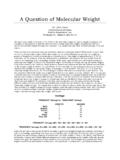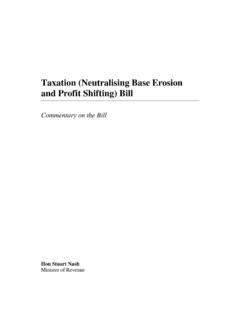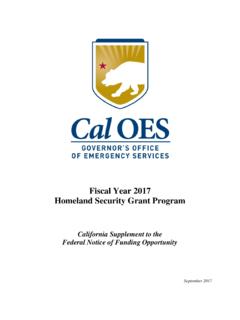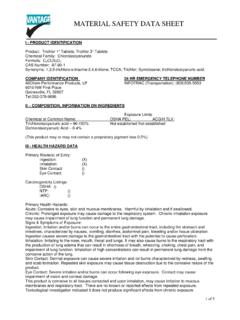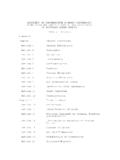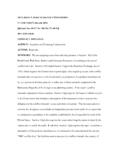Transcription of American Polymer Standards Corporation Safety …
1 American Polymer Standards Corporation Safety data Sheet Page 1 of 5 Polyacrylamide Section 1: Identification Product Name: Polyacrylamide EC Number: Not Available CAS Number: 9003-05-8 Product Nos.: PAM2950; PAM15K; PAM30K; PAM40K; PAM100K; PAM200K; PAM400K; PAM1000K; PAM1100K; PAAM3K; PAAM3500; PAAM9K; PAAM10K; PAAM20K; PAAM60K; PAAM80K; PAAM350K; PAAM500K; PAAM1000K; PAAM6000K; PAAM7000K; PAAM9000K Relevant Identified Uses of the Substance or mixture and uses advised against: Identified Uses: Laboratory Use Supplier/Manufacture: American Polymer Standards Corporation , 8680 Tyler Blvd., Mentor, OH 44060 Phone: 440-255-2211 * Fax: 440-255-8397 * Email: In Case of Emergency: (440) 255-2211 Section 2: Hazardous Identification Signal Word: None GHS: Not classified as hazardous per GHS; not listed in Table Annex VI of regulation 1272/2008/EU, as amended.
2 The product is not hazardous in the form in which it is placed on the market and under the normal and recommended conditions of storage and use. The product is not dangerous according to the criteria set by the EU. OHSA: While this material is not considered hazardous by OSHA Hazard Communications Standards (29 CFR ), this SDS contains valuable information critical to the safe handling and proper use of the product. This MSDS should be retained for employees and other users of this product. Potential Health Effects: Inhalation: May be harmful if inhaled. May cause respiratory tract irritation. Skin: May be harmful if absorbed through skin. May cause skin irritation. Eyes May cause eye irritation. Ingestion: May be harmful if swallowed. Low hazard in normal laboratory use.
3 The small quantities supplied in our products are unlikely to cause server or immediate health effects. Use only as directed and in accordance with safe laboratory practices. HMIS Classification: NFPA Rating: Health Hazards: 0 Health Hazard: 0 Flammability: 0 Fire: 0 Physical Hazards: 0 Reactivity Hazards: 0 Section 3: Composition/Information on Ingredients Substance/Mixture: Substance Chemical Name: Polyacrylamide Synonyms: PAM; PAAM Section 4: First-Aid Measures Description of Necessary First-Aid Measures Inhalation: Move person to fresh air; if effects occur, consult a physician Skin: Wash skin with plenty of water. Seek first-aid or medical attentions as needed. If molten material comes in contact with skin, do not apply ice but cool under ice water of running stream of eater.
4 DO NOT attempt to remove the material from skin. Removal could result in severe tissue damage. Seek medical attention immediately. Suitable emergency Safety shower facility should be immediately available. Eyes: Flush eyes thoroughly with water for several minutes. Remove contact lenses after the initial 1-2 minutes and continue flushing for several additional minutes. If effects occur, consult a physician, preferably an ophthalmologist. Ingestion: If swallowed, seek medical attention. May cause gastrointestinal blockage. Do not give laxatives. Do not induce vomiting unless directed to do so by medical personnel. Description of Symptoms/Effects (both acute and delayed) & Symptoms of Overexposure: Inhalation: No known significant effects of critical hazards. No specific data regarding symptoms of overexposure.
5 Skin: No known significant effects of critical hazards. No specific data regarding symptoms of overexposure. Eyes: No known significant effects of critical hazards. No specific data regarding symptoms of overexposure. Ingestion: No known significant effects of critical hazards. No specific data regarding symptoms of overexposure. Indication of Immediate Medical Attention & Special Treatment Needed, If Necessary: Note to Physician: Treat symptomatically. Contact poison treatment specialist immediately if large quantities have been ingested or inhaled. Specific Treatments: No specific treatment Protection of First-Aiders: No action shall be taken involving any personal risk or without suitable training. It may be dangerous to the person providing aid to give mouth-to-mouth resuscitation.
6 American Polymer Standards Corporation Safety data Sheet Page 2 of 5 Polyacrylamide Section 5: Fire-Fighting Measures Suitable Extinguishing Media: Use dry chemical powder, water spray (fog), foam or CO2 Unsuitable Extinguishing Media: Do not use water jet. Specific Hazards Arising from the Chemical: Carbon oxides, Nitrogen oxides Hazardous Thermal Decomposition Products: Decomposition products may include carbon oxides Special Protective Actions for Fire-Fighters: Promptly isolate the scene by removing all persons form the vicinity of the incident if there is a fire. No action shall be taken involving any personal risk or without suitable training. Move containers from fire area if this can be done without risk. Use water spray to keep fire-exposed containers cool.
7 Special Protective Equipment for Fire-Fighters: Fire-Fighters should wear appropriate protective equipment and self-contained breathing apparatus (SCBA) with a full face-piece operated in positive pressure mode. Section 6: Accidental Release Measures Personal Precautions, Protective Equipment & Emergency Procedures: Spilled material may cause a slipping hazard. Keep unnecessary and unprotected personnel from entering the area. Use appropriate Safety equipment. For additional information, refer to Section 8: Exposure Controls & Personal Protection. Environmental Precautions: Prevent from entering into soil, ditches, sewers, waterways and/or groundwater. For additional information, refer to Section 12: Ecological Information. Methods & Materials for Containment & Clean Up: Contain spilled material if possible.
8 Sweep up. Collect in suitable and properly labeled containers. For additional information, refer to Section 13: Disposal Considerations. Reference to other sections: See Section 1 for emergency contact information See Section 8 for information on appropriate personal protective equipment See Section 13 for additional waste treatment information Section 7: Handling & Storage Precautions for Safe Handling: Protective Measures: No smoking, open flames or sources of ignition in handling and storage areas. Wear appropriate personal protective equipment (refer to Section 8). Avoid inhalation. Avoid contact with eyes, skin and clothing. Avoid creation of dust. Ensure adequate ventilation. Electrical equipment and lighting should be protected to appropriate Standards to prevent dust coming ton contact with hot surfaces, sparks or other ignition sources.
9 Take precautionary measures against electrostatic discharges. To avoid fire or explosion, dissipate static electricity during transfer by earthing and bonding containers and equipment before transferring material. Advice on General Occupational Hygiene: Eating, drinking and smoking should be prohibited in areas where this material is handled, stored and processed. Workers should wash hands and face before eating, drinking and smoking. Remove contaminated clothing and protective equipment before entering eating areas. See Sections 8 for additional information on hygiene measures. Conditions for Safe Storage: Store in accordance with local regulations. Store in a segregated and approved area. Store in original container protected from direct sunlight. Keep container tightly closed in a dry and well-ventilated place, away from incompatible materials (see Section 10) and food and drink.
10 Eliminate all ignition sources. Separate from oxidizing materials. Keep container tightly closed and sealed until ready for use. Containers that have been opened must be carefully resealed and kept upright to prevent leakage. Do not store in unlabeled containers. Use appropriate containment to avoid environmental contamination. Section 8: Exposure Controls & Personal Protection Exposure Limits: Contains no substances with occupational exposure limit values. Engineering Controls: Safety shower and eye bath. Mechanical exhaust required. Personal Protective Measures: Respiratory: Respiratory protection is not required. Where protection from nuisance levels of dusts are desired, use type N95 (US) or type P1 (EN 143) dust masks. Use respirators and components tested and approved under appropriate government Standards such as NIOSH (SU) or CEN (EU).

